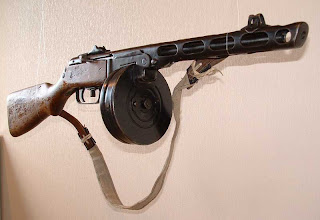The PPSh-41 was a Soviet submachine gun designed by Georgi S. Shpagin as an inexpensive, simplified alternative to the PPD-40. It was a short 33 inch (828mm) long blowback operated fully automatic submachine gun with a 10 inch (265mm) chrome lined barrel inside a wooden stock. Intended for use by minimally-trained conscript soldiers, the PPSh was a magazine-fed selective-fire submachine gun using an open-bolt, blowback action. It weighed 12 pounds (5.4 kg) when loaded with a 71-round drum magazine or about 9 1/2 pounds with the more reliable and preferred 35-round box magazine. It fired the same round as the Soviet Torkarev pistol, the 7.62x25mm cartridge. This bottlenecked cartridge was significantly more powerful than the 9x19mm Parabellum round used by German and Allied armies for submachine guns. The 7.62x25mm carried a 85grain bullet that came from the barrel at a scorching 1500 feet per second. In a pinch it could also fire the same 7.63x25mm round as the Broomhandle Mauser. Its rate of fire was a super fast 900 round per minute. This pistol sized round and the weight of the weapon allowed for practically no felt recoil when compared to other weapons.
About 5 million PPSh guns had been made by 1945, and the Soviets adapted their infantry tactics to take full advantage of such huge numbers: often complete units were armed with nothing else. In Russia, the PPSh went out of service in the late 1950s, but it has been supplied in enormous quantities to the satellite and pre-Communist countries, so that it will still be seen for many years. It has been made in various Communist countries, and in Iran, there are a multitude of variants. At one time, the German Army converted a few captured guns to 9mm by changing the barrel and magazine housing.
The PPSh saw extensive combat use during World War II and the Korean War. In the form of the Chinese Type 50 (a licensed copy), it was still in use in Vietnam with the Viet Cong as late as 1970. The PPSh also had a hinged receiver to facilitate field-stripping and cleaning the weapon. A chrome-lined bore enabled the PPSh to withstand both corrosive ammunition and long intervals between cleaning. No forward grip or forearm was provided, and the operator generally had to grasp the weapon behind the drum magazine with the supporting hand, or else hold the lower edge of the drum magazine. Though 35-round curved box magazines were available from 1942, the average Soviet infantryman in World War II carried the PPSh with the original 71-round drum magazine.
Specifications:
Cartridge: 7.62x25 (interchangeable with 7.63 Mauser; aka- .30 Mauser)
Type of Operation: Blowback
Cyclic rate: 900 rpm
Muzzle velocity: c.1600fps (488mps)
Type of Fire: Selective: full-automatic and semi-automatic
Length: 33.10 in. (828mm)
Barrel: 4 grooves, right-hand twist
Barrel Length: 10.60 in (265mm)
Weight unloaded: 8 lbs. (3.64 kg), with drum 12 lbs. (5.40 kg)
Type of Feed Mechanism: Single position feed, stamped sheet-metal, curved box magazine. Also, a drum magazine similar to the PPD type, but possessing two feed lips.
Magazine capacity: 35 round detachable box or 71 round drum.
Weight of Loaded Magazines: 1.5 lbs, box type (.680 kg), 4 lbs. drum type (1.840 kg)
Sights: Tangent with open "U" notch, adjustable from 50 to 500 meters. On the later models, there is an open "U" notch "L" flip rear sight set for 100 and 200 meters.



